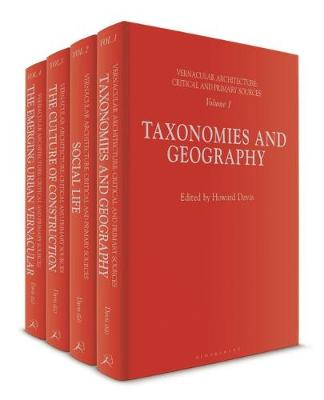Critical and Primary Sources
1 total work
Vernacular Architecture
Published 22 April 2021
Vernacular Architecture: Critical and Primary Sources brings together for the first time a collection of essential and foundational readings in the study of vernacular architecture and the traditional building cultures of the world.
Collating scholarly historical texts from the last 200 years from a wide range of sources, this four-volume set offers a key knowledge resource for the field. It creates for the first time a comprehensive framework through which to understand the critical aspects and diverse interpretations of vernacular architecture studies, vital to much ongoing research in the built environment, in heritage studies, and material culture studies.
Each volume includes a substantial contextualizing introduction, while the texts are arranged according to themes which correspond to the chronological and intellectual development of the field, reflecting the subject's evolution from primarily rural, romantic and traditional interpretations through to thoroughly contemporary and interdisciplinary definitions of the field. These contemporary perspectives connect to new scholarship on the explosive growth of cities and the global urban future - and are thus the concern not only of scholars who are seeking to understand the built world but also of professional architects, planners and citizens who continue to draw lessons from the vernacular and to apply them to design, procedures and political formations. Accordingly, this is a reference collection which enables both a critical understanding of the subject and a way to connect theory with contemporary professional practice.
This work will represent an essential addition to libraries and a major scholarly resource for architecture, building conservation / historic preservation, town planning, material culture, art history, geography, and heritage studies.
Collating scholarly historical texts from the last 200 years from a wide range of sources, this four-volume set offers a key knowledge resource for the field. It creates for the first time a comprehensive framework through which to understand the critical aspects and diverse interpretations of vernacular architecture studies, vital to much ongoing research in the built environment, in heritage studies, and material culture studies.
Each volume includes a substantial contextualizing introduction, while the texts are arranged according to themes which correspond to the chronological and intellectual development of the field, reflecting the subject's evolution from primarily rural, romantic and traditional interpretations through to thoroughly contemporary and interdisciplinary definitions of the field. These contemporary perspectives connect to new scholarship on the explosive growth of cities and the global urban future - and are thus the concern not only of scholars who are seeking to understand the built world but also of professional architects, planners and citizens who continue to draw lessons from the vernacular and to apply them to design, procedures and political formations. Accordingly, this is a reference collection which enables both a critical understanding of the subject and a way to connect theory with contemporary professional practice.
This work will represent an essential addition to libraries and a major scholarly resource for architecture, building conservation / historic preservation, town planning, material culture, art history, geography, and heritage studies.
